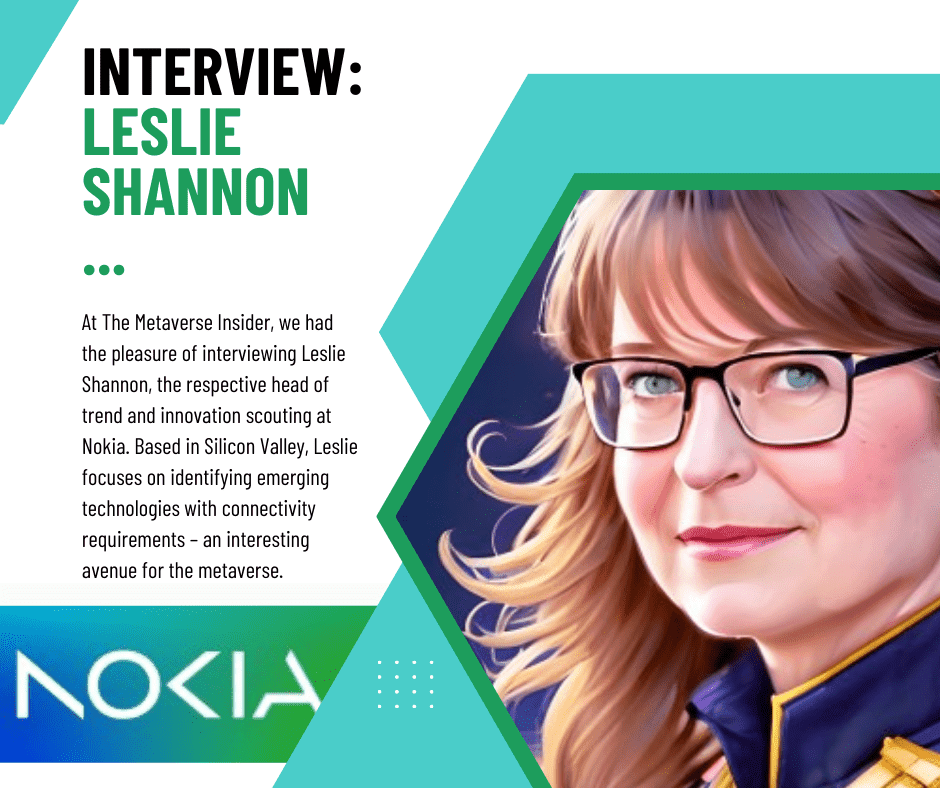The Metaverse Insider had the opportunity to interview Leslie Shannon, the esteemed leader in trend and innovation scouting at Nokia. Based in Silicon Valley, Leslie’s primary focus is to identify emerging technologies that require connectivity, which presents an intriguing prospect for the metaverse.
Nokia, no longer engaged in phone manufacturing, has shifted its specialization to providing network equipment and services to mobile companies and large enterprises. Leslie’s responsibility entails keeping Nokia and its clients up to date on new connectivity-dependent technologies and assisting in the establishment of networks to meet those requirements. With her extensive experience of delving into augmented reality, virtual reality, and visual analytics over the past five to six years, Leslie possesses a deep understanding of metaverse initiatives.
The importance of partnerships in the metaverse
Nokia has discreetly made remarkable progress in the realm of network connectivity as it undergoes a transition from being a phone manufacturer. While Leslie has long been involved in the field of connectivity, the present technological landscape has elevated its significance to unprecedented levels:
“I’ve been with Nokia for 23 years, and I’ve always been on the network side… We’ve always done this. And now, that’s the headline. So yes, we’re really pleased to be able to bring our expertise into this.”
Highlighting the collaborative nature of the metaverse industry, Leslie emphasizes that no single company can build the metaverse alone. She mentions that Nokia works with numerous partners in various areas such as hardware, software, chipsets, and headsets – however, while Leslie refrains from disclosing specific names, she affirms that Nokia collaborates extensively with other industry players:
“We’re all talking to each other. And we’re all working together to make sure that this goes forward. It’s in all of our interests.”
“Okay, we do work with a lot of names that you have heard of… But let’s just say that all of the players are from hardware, software, chipset, headset… we’re all talking to each other.”
Leslie explains that metaverse projects require a diverse mosaic of players to bring them to life. She mentions the involvement of hardware manufacturers, AR coders, network operators, and mapping companies, each contributing their expertise to the overall ecosystem. Leslie draws from her experience at Nokia, specifically in the early days of 3G technology, where she learned that coordinating projects with multiple entities can be challenging from a business perspective:
“So, one of the really key success factors going forward in this Metaverse world is going to be business agility. The ability to work with multiple partners at once.”
“The ones with a win-lose mindset are going to end up losing because we need partners so much… If you screw the guys that you’re working with, word is going to get out fast. No one’s going to work with you and you’re dead in the water.”
Furthermore, Leslie mentions the need for large companies, like Nokia, to adopt humility in the metaverse industry. She points out that significant advancements and crucial technologies often originate from smaller, more agile companies. Thus, big companies cannot rely on their size and dominance to impose their will, as it would deter collaboration:
“Large companies need to learn to be humble here; a lot of the really important new technology and a lot of the important developments are coming from the smaller companies, the more agile companies.”
“Big companies are used to being like, ‘Hey, you know, I’m the 600-pound gorilla, I get my way’. No, if you behave that way, again, nobody’s going to want to play with you.”
The metaverse offers multiple options for each aspect, and success lies with those who refrain from exerting excessive influence. Leslie encourages a collaborative approach, particularly between larger and smaller companies. She believes that lifting smaller companies instead of suppressing them will create an environment conducive to long-term success. By fostering partnerships and mutual support, companies can collectively shape the metaverse landscape.
Leslie Shannon’s vision of the future of the space
Leslie provides an in-depth vision of how augmented reality (AR) headsets will evolve over the next 10 years and their potential impact on our daily lives. She foresees a future where AR headsets closely resemble regular eyeglasses and offer highly contextual information and entertainment tailored to individual requests.
Leslie also identifies a key issue with the current reliance on two-dimensional screens, where our attention becomes absorbed, disconnecting us from our immediate surroundings. She explains that AR glasses will solve this problem by allowing users to regain their gaze, reconnecting with their environment, and freeing up their hands for other tasks:
“We’re not looking into the eyes of the people with us anymore. We’re not paying attention to our surroundings anymore. We’re all stuck on our screens.”
To illustrate the possibilities, Leslie shares a practical example of using AR glasses to identify bird species while walking her dog. Instead of struggling with a leash in one hand and a smartphone in the other, she envisions a seamless experience where she can simply ask the glasses to identify a bird, receiving a real-time response either through text or voice.
Looking ahead, Leslie delves into the transformative potential of generative artificial intelligence (AI) integrated into AR glasses. She describes a scenario where, observing a plane taking off near San Jose airport, she wonders about its destination. With the glasses, she envisions the ability to generate a program that connects to public flight databases, performs visual recognition of the plane’s livery, and provides immediate information on its destination.
Furthermore, Leslie emphasizes the democratization of coding by envisioning a future where individuals can write programs on the fly through their AR glasses. She believes this accessibility to coding through AR glasses will empower users to create customized applications and solutions as ideas arise:
“That’s where we’re going in 10 years. But there are a lot of things that need to fall into place for that to happen. And I’m not sure how much of that will be in place after five years.”

















